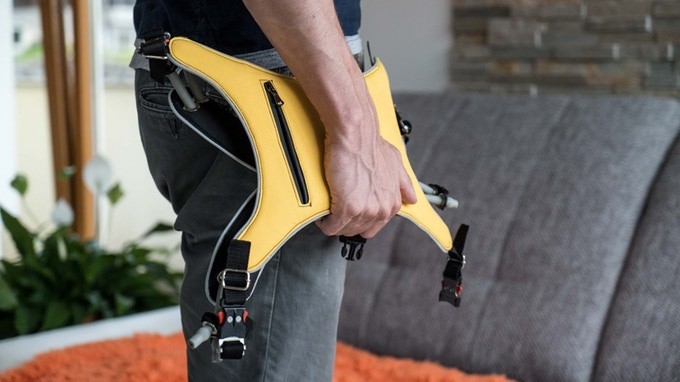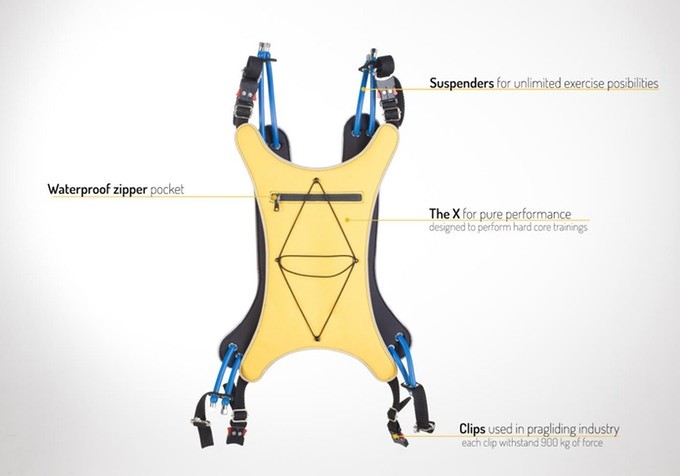Wibe is the Coolest Wearable Kickstarter That Nobody Knows About
NewsTech October 23, 2023 Damon Mitchell

On June 26, 2017, the team behind Wibe, Atlexa, relaunched their Kickstarter after suffering some kind of rights infringement from the first name of their product. Wibe a backpack or back part accessory of sorts, with workout bands, ensuring that everywhere one goes, she gets a workout.
To date, Atlexa’s Kickstarter is not even $6,000 in the bank on a $35,000 goal, but it has to be a mistake. This simple low-tech wearable is one of the smartest ideas to hit wearables in a long time.
About a year ago, Body Hacks filled its pages with regular wearables content. Last year, we made the decision to streamline the focus of the content to only that which enhances the human experience, which left much of the wearables universe out in the cold–a sad comment on wearables IMHO.
This product, however, adds a smart layer of variable resistance to everyday life. The added work is such that one might not even notice the changes in strength over time. It’s genius.
We’re all gonna miss out if this writer is the only one who sees the potential.
Variable Resistance
When this writer went through his first personal training certification, the American Council on Exercise (ACE) basic cert, there was a long section on types of resistance.
With years under my belt in lifting already, the course content pried open my mind about how all resistance isn’t created equal.
Without getting too nerdy, we divide it into two basic categories: the kind of resistance that stays the same throughout a movement, called constant or fixed resistance, and variable. The latter changes.
Imagine a bench press that increased or decreased in perceived weight. Variable resistance systems use pistons, computers or simple elastic bands to vary the load.
The elastic band version is popular because bands are cheap, portable, and they mirror the tension in our muscles when we use them. They’re like anti-muscles.
Sticking with the bench press example, strength coaches sometimes implement bands into the lift, creating variable resistance in order to push their athlete’s past plateaus.
The problem with bands is finding creative ways to use them. One only has two hands and two feet. Also, there’s the question of what to do with them when not in use.
The Wibe system answers this question.
Wibe
The solution from Wibe puts bands into a system which, when not in use, retracts out of the way. When someone wants to kick a little extra resistance into life, out come the bands.
This is a weird idea when one is cutting across campus, late to sociology. It is, however, a stellar idea when one engages in cardio.
The Wibe bands, in this context, function like a more dynamic version of the weighted vest folks like to don. Those only add resistance to the legs, which is good, but Wibe imagines a more complete workout.
From their promotional video, swimming with Wibe seems like a nice value add. Swimmers can only ever increase intensity by moving faster. They can’t make water more resistant.
Swimmers could, as an alternative, go swimming in a pool of canola oil, but Wibe would be so much easier.
Consider this other example. In the gym, blazing past all the reasons this premise stinks (cost, other people, smelly, time-consuming), one can arrange interval workouts which include resistance and cardio training. That’s, assuming the gym isn’t too busy.
With Wibe, the lift goes with the exerciser. A run in the park could turn into an easy interval workout, stopping every few minutes for a little resistance, no waiting for someone to finish his set.
The alternative is to carry dumbbells on the trail or even Wibe’s predecessor, loose elastic bands.
One could throw those loose bands in a backpack, but then what? Fish them out for each resistance interval? Waste time looking for somewhere to anchor them? Then, put them back in the bag?
With Wibe, one simply drops the bands or better yet, hangs on for the super-resistance cardio session.
Specifics
The Atlexa team makes a lot of promises with their product. It’s lightweight, weatherproof, and has night reflection properties. They promise 160 plus exercises, which is legit.
Bands are only limited by creativity and anchor points, and Wibe solves the latter. The first version comes in three colors, Future versions will offer more technology, like digitization, and mobile apps. They’ll add more colors and children’s sizes.
What Atlexa does not address on their Kickstarter pitch is the dark truth about resistance bands. They break.
Atlexa promises their product is “built with the latest materials used by the military and those in the paragliding industry. They are the strongest, most durable materials currently on the market.” This sounds good, but nothing lasts forever. Elastic band life is even shorter.
One who invests in this product should hope for band replacements. They are going to break, probably at the most inopportune time, but it’s a reality. Setting buyers up to expect something different is a ticking time bomb.
For all the space-age durability promised with Wibe, this writer would like to hear about a band replacement program. From a business perspective, it could mean passive income for Atlexa.
Put people on automatic re-up plans to ship replacement bands every 30-90 days; auto-ship, auto-bill, but give buyers the chance to stop shipments if they have enough bands.
Here’s hoping that the good folks at Atlexa see their Kickstarter take a strong step forward.
Worst case scenario, they’ll eat their investment and have some cool prototypes for personal use. Best case scenario, investors will get a sweet system for working out whenever and wherever they please.
Want to know more? Check out their Kickstarter or watch this sweet product video. Body hacks received no affiliate pay for this blog.

